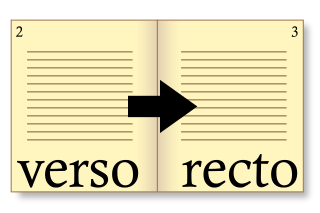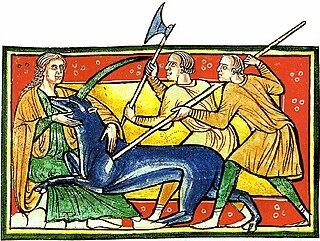
The Aberdeen Bestiary is a 12th-century English illuminated manuscript bestiary that was first listed in 1542 in the inventory of the Old Royal Library at the Palace of Westminster. Due to similarities, it is often considered to be the "sister" manuscript of the Ashmole Bestiary. The connection between the ancient Greek didactic text Physiologus and similar bestiary manuscripts is also often noted. Information about the manuscript's origins and patrons are circumstantial, although the manuscript most likely originated from the 13th century and was owned by a wealthy ecclesiastical patron from northern or southern England. Currently, the Aberdeen Bestiary resides in the Aberdeen University Library in Scotland.

The Book of Kells is an illustrated manuscript and Celtic Gospel book in Latin, containing the four Gospels of the New Testament together with various prefatory texts and tables. It was created in a Columban monastery in either Ireland or Scotland, and may have had contributions from various Columban institutions from each of these areas. It is believed to have been created c. 800 AD. The text of the Gospels is largely drawn from the Vulgate, although it also includes several passages drawn from the earlier versions of the Bible known as the Vetus Latina. It is regarded as a masterwork of Western calligraphy and the pinnacle of Insular illumination. The manuscript takes its name from the Abbey of Kells, County Meath, which was its home for centuries.
An HTML element is a type of HTML document component, one of several types of HTML nodes. The first used version of HTML was written by Tim Berners-Lee in 1993 and there have since been many versions of HTML. The current de facto standard is governed by the industry group WHATWG and is known as the HTML Living Standard.

APA style is a writing style and format for academic documents such as scholarly journal articles and books. It is commonly used for citing sources within the field of behavioral and social sciences, including sociology, education, nursing, criminal justice, anthropology, and psychology. It is described in the style guide of the American Psychological Association (APA), titled the Publication Manual of the American Psychological Association. The guidelines were developed to aid reading comprehension in the social and behavioral sciences, for clarity of communication, and for "word choice that best reduces bias in language". APA style is widely used, either entirely or with modifications, by hundreds of other scientific journals, in many textbooks, and in academia. The current edition is its seventh revision.
An advance reading copy, advance review copy, advance reader's edition, advance copy, or a reader's edition is a free copy of a new book given by a publisher to booksellers, librarians, journalists, celebrities, or others, or as a contest or school prize, before the book is printed for mass distribution.

Recto is the "right" or "front" side and verso is the "left" or "back" side when text is written or printed on a leaf of paper in a bound item such as a codex, book, broadsheet, or pamphlet.

The Vergilius Romanus, also known as the Roman Vergil, is a 5th-century illustrated manuscript of the works of Virgil. It contains the Aeneid, the Georgics, and some of the Eclogues. It is one of the oldest and most important Vergilian manuscripts. It is 332 by 323 mm with 309 vellum folios. It was written in rustic capitals with 18 lines per page.

In graphic design, page layout is the arrangement of visual elements on a page. It generally involves organizational principles of composition to achieve specific communication objectives.

Book design is the art of incorporating the content, style, format, design, and sequence of the various components and elements of a book into a coherent unit. In the words of renowned typographer Jan Tschichold (1902–1974), book design, "though largely forgotten today, [relies upon] methods and rules upon which it is impossible to improve, [and which] have been developed over centuries. To produce perfect books, these rules have to be brought back to life and applied". Richard Hendel describes book design as "an arcane subject", and refers to the need for a context to understand what that means.

A frontispiece in books is a decorative or informative illustration facing a book's title page, usually on the left-hand, or verso, page opposite the right-hand, or recto page of a book. In some ancient editions or in modern luxury editions the frontispiece features thematic or allegorical elements, in others is the author's portrait that appears as the frontispiece. In medieval illuminated manuscripts, a presentation miniature showing the book or text being presented was often used as a frontispiece.

The term "folio" has three interconnected but distinct meanings in the world of books and printing: first, it is a term for a common method of arranging sheets of paper into book form, folding the sheet only once, and a term for a book made in this way; second, it is a general term for a sheet, leaf or page in (especially) manuscripts and old books; and third, it is an approximate term for the size of a book, and for a book of this size.

Page numbering is the process of applying a sequence of numbers to the pages of a book or other document. The number itself, which may appear in various places on the page, can be referred to as a page number or as a folio. Like other numbering schemes such as chapter numbering, page numbers allow the citation of a particular page of the numbered document and facilitates to the reader to find specific parts of the document and to know the size of the complete text.

An intentionally blank page is a page that has no content and may be unexpected. Such pages may serve purposes ranging from place-holding to space-filling and content separation. Sometimes, these pages carry a notice such as "This page was intentionally left blank." Such notices typically appear in printed works, such as legal documents, manuals, and exam papers, in which the reader might otherwise suspect that the blank pages are due to a printing error and where missing pages might have serious consequences.
Indicia, from the plural of the Latin word indicium meaning distinguishing marks, is a piece of text in a magazine or comic book, traditionally appearing on the first recto page after the cover, which usually contains the official name of the publication, its publication date, issue number, information regarding editorial governance of the publication, and a disclaimer regarding disposition of unsolicited submissions.
XFrames was an XML format draft for embedding HTML pages into one page which handles the layout without the problems of HTML Frames. This technique has been especially popular for navigation bars. While HTML Frames are still supported for legacy websites, today websites combine the page on the server instead.
jQuery Mobile is a touch-optimized web framework, specifically a JavaScript library, developed by the jQuery project team. The development focuses on creating a framework compatible with many smartphones and tablet computers, made necessary by the growing but heterogeneous tablet and smartphone market. The jQuery Mobile framework is consistent with other mobile app frameworks and platforms such as PhoneGap, Worklight, etc.

In typography and word processing, the page footer of a printed page is a section located under the main text, or body. It is typically used as the space for the page number. In the earliest printed books it also contained the first words of the next page; in this case they preferred to place the page number in the page header, in the top margin. Because of the lack of a set standard, in modern times the header and footer are sometimes interchangeable. In some instances, there are elements of the header inserted into the footer, such as the book or chapter title, the name of the author or other information. In the publishing industry the page footer is traditionally known as the running foot, whereas the page header is the running head.

The following outline is provided as an overview of and topical guide to books.

The Worksop Bestiary, also known as the Morgan Bestiary, most likely from Lincoln or York, England, is an illuminated manuscript created around 1185, containing a bestiary and other compiled medieval Latin texts on natural history. The manuscript has influenced many other bestiaries throughout the medieval world and is possibly part of the same group as the Aberdeen Bestiary, Alnwick Bestiary, St.Petersburg Bestiary, and other similar Bestiaries. Now residing in the Morgan Library & Museum in New York, the manuscript has had a long history of church, royal, government, and scholarly ownership.

Papyrus 137 is a late 2nd or early 3rd century fragment of the first chapter of the Gospel of Mark The fragment is from a codex and has been published in the Oxyrhynchus papyrus series as P.Oxy. LXXXIII 5345.





















